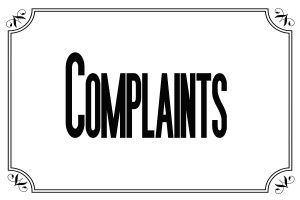No Device Complaints – No Problems? Think Again
August 26th, 2013 // 12:09 pm @ jmpickett
Latest FDA and cGMP Compliance News
FDA states that a complaint is any written, oral or electronic communication that is alleging there are deficiencies in a product related to the quality, durability, identity, safety, reliability, performance or effectiveness of a medical device after it is released to the market. Note that the ISO 13485 definition is similar to the FDA definition. The complaint regulations for FDA are noted in CFR 820.198.
In recent months, we have been in contact with some medical device firms that want to improve their complaint handling policies. This is a good idea, because FDA often hands out 483s and warning letters for improper complaint handling procedures. Here is a good example of how critical it is to manager your complaints:
This client was audited by FDA a few months before. The firm was making a Class II medical device and had done it for decades. And yet, there had never been a complaint documented! Very impressive, right? Or suspicious. Obviously, the firm does not fully understand what a ‘complaint’ is. The device can be reused, and the firm had many records stating that the device was repaired out in the field. They claimed that these repairs were just normal wear and tear, and were not an indicator that their device had any sort of deficiency. While they did have records of their device repairs, they did not have any records of other communications from customers about their device. FDA issued them a 483 for this, and they followed that with a warning letter.
FDA told the company to do several things. First, they needed to define their complaint handling processes and conduct a complete review retrospectively of their device repairs to see what could be classified as a complaint.
The company needed to be educated by a consultant about what a complaint really is, and also some information about the Quality System Regulations. The training went well and enlightened the client, but the consultant was disturbed. This firm had been making these devices for decades and had little knowledge of essential FDA regulations.
After this training, he came up with a complaint procedure, which included a process flowchart to explain each part in this process. He also came up with a new complaint form to follow along the process. He went over each item with the firm, and got more questions about what complaints are and are not.
Next, they went over their past repair records. He looked at the top clients, and after he looked at the first 25 records, he figured that about half of them could be a complaint potentially. He then forwarded this data to the client and indicated that if any of the files he indicated were NOT complaints, they needed to document and justify the reason. As of this writing, he had not heard back from the client.
The consultant has been trying to grasp why the complaint topic is so difficult with this client. He speculates:
- The complaint indicates to them that their product is inferior so they don’t want to document it
- They believe that IDing complaints would make FDA take notice
- Logging complaints is irrelevant because the firm will always make repairs and fix issues
- Documenting complaints takes too much time
The consultant hopes that the firm understands that installing a strong complaint handling system will help them to improve their product, but at this point, he can’t tell if this client is going to do it or not.
For much more information about how to implement essential complaint handling procedures, please review our upcoming Webinar – The Essentials of Complaint Handling and Post Market Management.



